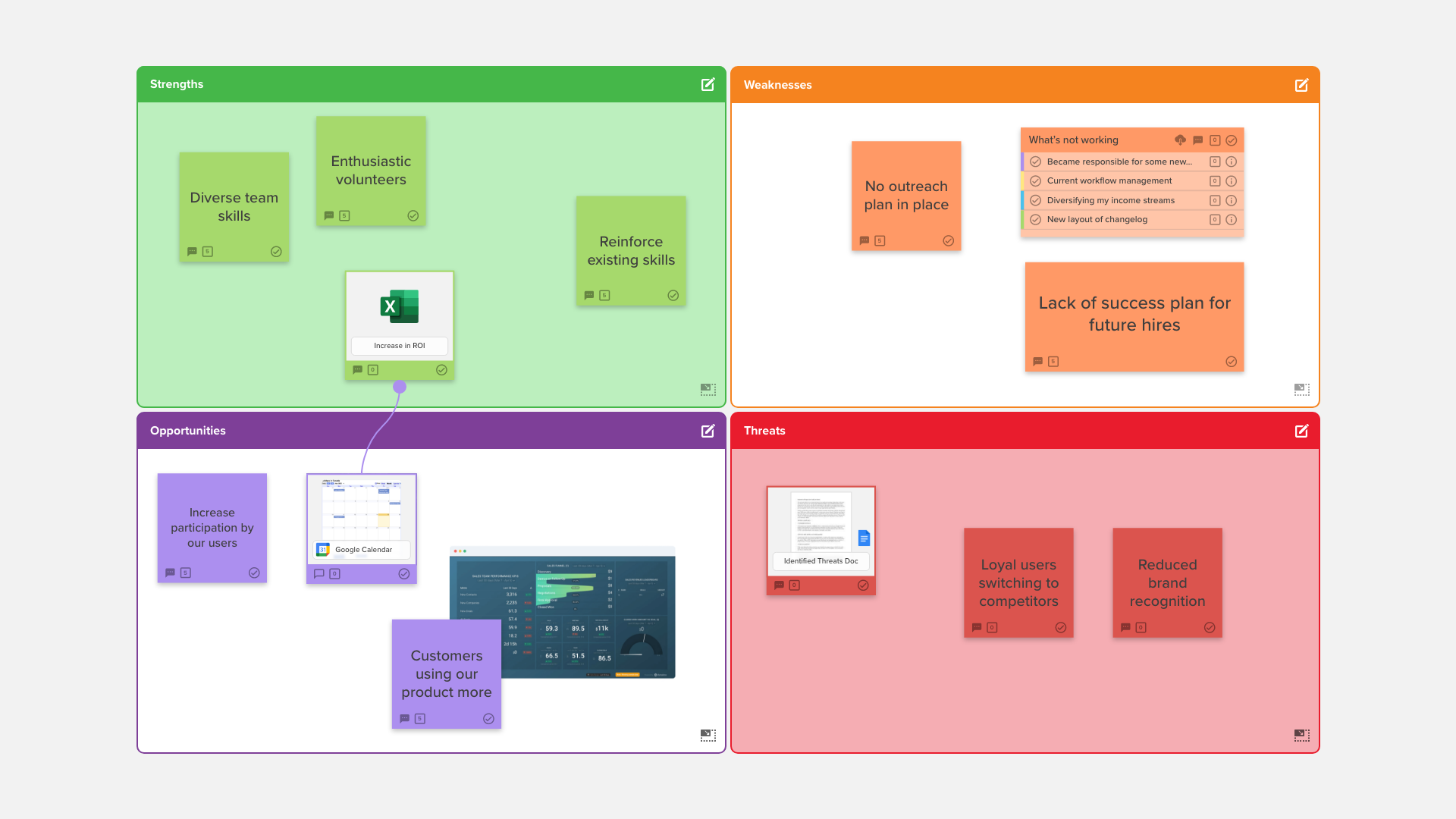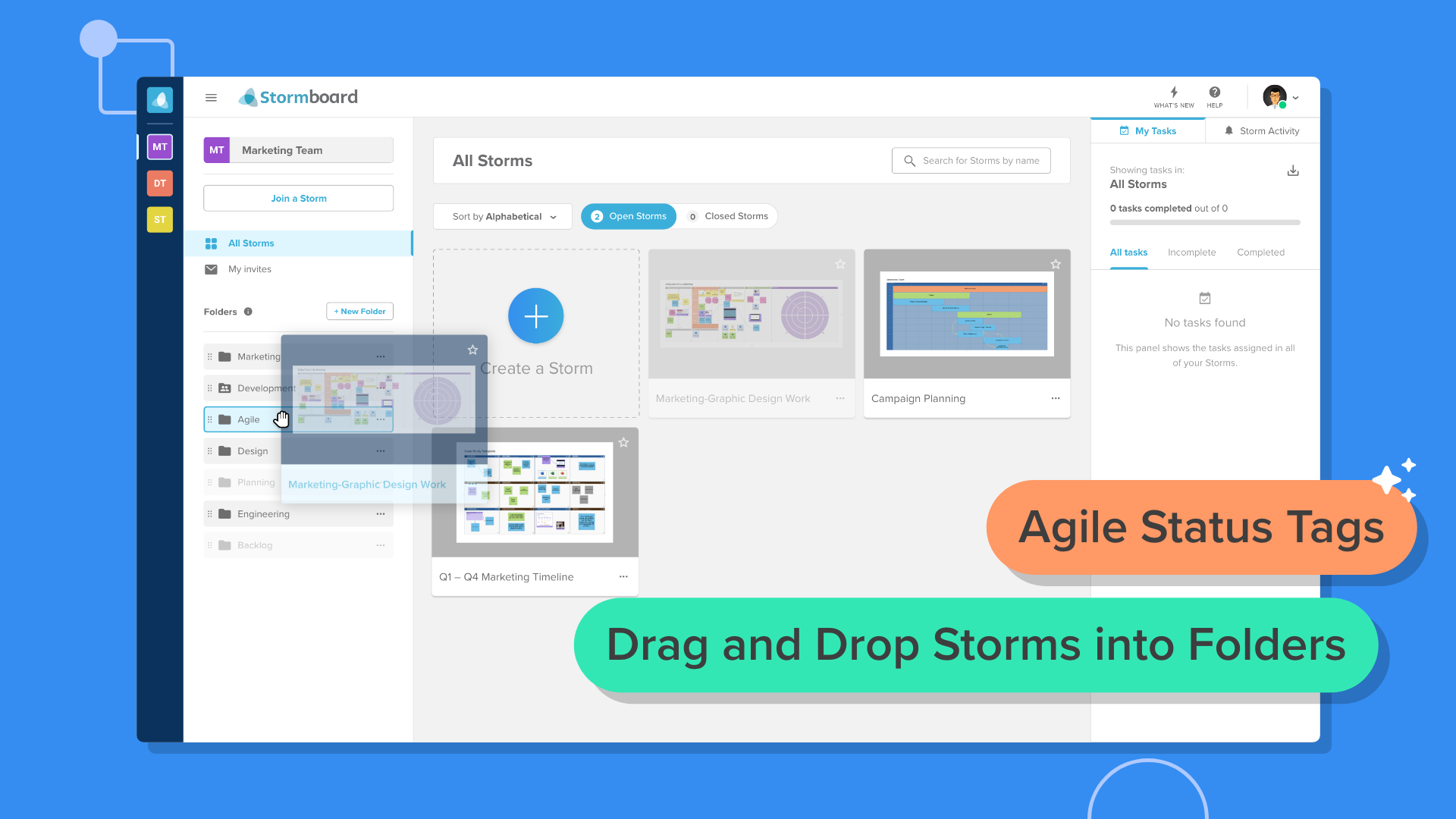How SWOT Analysis Can Help Improve Your Business Strategy
In today's cutthroat business landscape, long-term success is not just about survival; it's about thriving. It requires a willingness to adapt and evolve with the changing tides of the market. That's where strategic planning comes in. It's the compass that guides businesses toward their goals and helps them stay ahead of the competition.
But what exactly is the key to successful strategic planning? One word: SWOT. This powerful tool allows businesses to take a deep dive into their strengths, weaknesses, opportunities, and threats. By analyzing these key factors, they can craft a strategy that will propel them toward success.
In this article, we'll explore how SWOT analysis can help businesses achieve their goals in a data-driven collaborative environment. We'll take a closer look at the benefits of using Stormboard as a platform for conducting SWOT analysis, and how it can help teams work together more efficiently than ever before.
Ready to take your strategic planning to the next level? Let’s dive in.
The Importance of Strategic Planning
In a world where businesses are constantly faced with new challenges and opportunities, having a well-defined strategic plan is crucial. A solid strategy helps organizations:
Define clear objectives and goals
Allocate resources effectively
Identify growth opportunities
Mitigate risks
Enhance overall business performance
Therefore, it's imperative for businesses to prioritize strategic planning to achieve long-term success and stay competitive in the ever-evolving market.
Understanding SWOT Analysis
SWOT analysis is a structured process that helps businesses identify their internal strengths and weaknesses, as well as external opportunities and threats. This approach allows organizations to gain a comprehensive understanding of their current situation, enabling them to make informed decisions and create a robust strategy.
What does SWOT stand for?
Strengths: Positive internal attributes that give your business an advantage. These might include a strong brand reputation, a loyal customer base, efficient supply chain management, or exclusive patents.
Weaknesses: Negative internal attributes that hinder your business. Examples might include high employee turnover, outdated technology, limited resources, or a weak online presence.
Opportunities: External factors that your business can capitalize on. These could involve emerging market trends, new technological advancements, strategic partnerships, or government incentives.
Threats: External factors that pose challenges to your business. These may include increased competition, economic downturns, regulatory changes, or supply chain disruptions.
The Role of SWOT Analysis in Strategic Planning
SWOT analysis is an important part of strategic planning as it helps businesses identify areas for improvement and growth. By understanding their strengths, weaknesses, opportunities, and threats, businesses can make informed decisions and develop action plans to address identified issues.
It's most effective when conducted regularly, during major decision-making processes, or when facing significant changes.
Timing and Frequency of SWOT Analysis
To maximize the benefits of SWOT analysis, businesses should conduct them:
At regular intervals (e.g., annually or bi-annually).
During strategic planning sessions.
When considering new products or services.
When entering new markets or facing increased competition.
In response to significant changes in the business environment.
By conducting SWOT analyses periodically and in response to specific triggers, businesses can stay agile and adapt their strategies to evolving circumstances.
Aligning SWOT with Business Strategy
In the competitive world of business, understanding your company's strengths and weaknesses can make all the difference. By identifying the areas where you excel and those that require improvement, you can take proactive steps to optimize your business's performance and gain a valuable edge over your rivals.
Internal Factors: Strengths and Weaknesses
Consider your strengths: Do you have a team of skilled and experienced professionals who consistently produce high-quality work? Does your brand enjoy a reputation for excellence and reliability?
Perhaps you offer unique products or services that set you apart from your competitors. Maybe you've streamlined your supply chain to achieve maximum efficiency and cost savings. Or perhaps your company culture fosters positivity, innovation, and a strong sense of community.
On the other hand, weaknesses can hinder your business's growth and profitability. Are you struggling with limited financial resources? Is your technology outdated or in need of an upgrade? Are you grappling with poor management or leadership that's holding your team back?
Do you have a high employee turnover rate that's impacting productivity and morale? Or are your marketing efforts falling short, making it difficult to reach new customers and expand your brand's reach?
By taking a close look at these internal factors, you can develop a clear understanding of where your business stands and what steps you need to take to move forward. With this knowledge, you can make strategic decisions, invest in the areas that matter most, and unlock your business's full potential.
Developing Strategies for Strengths and Weaknesses
It's crucial to have a solid plan in place to leverage your company's strengths and address its weaknesses. To help you achieve this, consider implementing the following strategies:
Capitalize on your strengths by promoting and expanding the areas where your business excels. This could involve investing in resources such as technology, and marketing, or hiring top talent to help you maintain a competitive edge.
Identify the root causes of your weaknesses and develop actionable plans to overcome them. This may involve investing in new technology to streamline processes, reorganizing management structures to improve communication and decision-making, or enhancing employee training programs to develop new skills and knowledge.
By actively implementing these strategies, businesses can not only achieve short-term success but also ensure long-term growth and sustainability. Don't wait until it's too late to address your weaknesses or capitalize on your strengths.
With the right plan in place, your company can thrive in today's competitive business environment (Inc).
External Factors: Opportunities and Threats
As a business owner or manager, it's important to be aware of external factors that can impact your organization. These external factors can present both opportunities and threats. Here are some key points to consider when assessing external factors.
Opportunities
New markets or customer segments: Look for untapped markets or customer segments that your business could expand into.
Technological advancements: Keep an eye on emerging technologies that could benefit your business, such as artificial intelligence, automation, or the Internet of Things.
Favorable regulations or government policies: Changes in regulations or policies could create new opportunities for your business. Stay up to date on any changes that could impact your industry.
Industry trends or emerging niches: Keep abreast of trends and emerging niches in your industry. Identify areas where your business could grow or pivot.
Partnerships or collaborations with other businesses: Consider partnerships or collaborations with other businesses that could bring mutual benefits.
Threats
Increased competition in the market: Keep an eye on competitors, both current and potential, and be prepared to adapt to changing market dynamics.
Economic downturns or recessions: Prepare for potential economic downturns by ensuring your business has a solid financial foundation.
Changing consumer preferences or demographics: Monitor changes in consumer preferences and demographics that could impact your business. Be prepared to adapt to shifting customer needs.
Unfavorable regulations or government policies: Stay aware of any changes in regulations or policies that could negatively impact your business.
Disruptive technologies: Look out for emerging technologies that could disrupt your business model. Be prepared to adapt or pivot if necessary.
By staying aware of external factors and taking a proactive approach, you can position your business for success in a constantly evolving marketplace.
Developing Strategies for Opportunities and Threats
Recognizing these factors and creating strategies to capitalize on opportunities and mitigate threats helps businesses advance their strategic goals. Some possible approaches include:
Exploiting opportunities: Develop plans to seize new opportunities, such as expanding into new markets, adopting innovative technologies, or forming strategic partnerships.
Mitigating threats: Monitor external factors and create contingency plans to minimize their impact, such as diversifying your product portfolio, improving cost-efficiency, or investing in research and development.
By proactively addressing external factors, businesses can adapt to changes and remain competitive in the ever-evolving market landscape.
Examples of SWOT Analysis
Let's consider a fictional company, call it GreenTech Innovations; it’s a start-up specializing in eco-friendly technology solutions. They decided to conduct a SWOT analysis to identify strategic growth opportunities.
Here’s a breakdown of their hypothetical SWOT analysis.
Strengths:
Expertise in sustainable technology
Strong company culture focused on environmental values
Top-to-bottom employee buy-in to company goals and values
Weaknesses:
Limited financial resources
Lack of brand recognition
New entrant into a (historically) niche space
Opportunities:
Growing demand for green technology products
Potential government incentives for eco-friendly businesses
Increasing global attention on Corporate Social Responsibility
Threats:
Intense competition from larger, well-established companies
Possible changes in environmental regulations
Costs and overhead compared to traditional technologies
By analyzing these factors, GreenTech Innovations could leverage its expertise and strong culture to create unique products that cater to the increasing demand for green technology solutions. They could also explore government incentives to help mitigate their financial limitations and invest in marketing campaigns to build brand recognition.
SWOT Example #2
For another example, let's look at a a fictional mid-sized retail company on the East Coast of the United States - Fashion Forward. They are the opposite of a fresh startup like GreenTech Innovations. Fashion Forward has been around for decades, but are now facing declining sales and increased competition from e-commerce giants. They decided to use SWOT analysis to re-evaluate their business strategy.
Strengths:
Loyal customer base
Talented in-house designers
Existing inventory and established manufacturing & logistics process
Weaknesses:
Outdated store design
Limited online presence
Geographically limited
Opportunities:
Expanding into e-commerce
Collaborating with popular social media influencers
Originality and exclusivity
Threats:
Rapid growth of e-commerce competition
Changing consumer preferences
Cheaper and more cost-effective alternatives
Fashion Forward identified the need to expand into e-commerce and refresh their store design to remain competitive. They also recognized the potential to collaborate with social media influencers to reach new customers and capitalize on their loyal customer base. While they realized they were never going to compete with big-box stores, they decided they could lean into their original designs and exclusivity to differentiate themselves from mass-produced alternatives.
These examples demonstrate how businesses can use SWOT analysis to identify internal and external factors that impact their success and create strategic plans to address challenges and seize opportunities.
Collaborative SWOT Analysis using Stormboard
Stormboard is a data-first collaborative workflow platform that transforms unstructured interactions into data-rich collaborative workspaces, making it an ideal choice for conducting a SWOT analysis.
We also have a handy SWOT 101 guide made to help you perform a SWOT in Stormboard!
The benefits of using Stormboard’s SWOT analysis template include:
Real-time Collaboration
Stormboard enables real-time communication and input from team members, allowing for more efficient collaboration and better decision-making. Gone are the days of chaotic, pointless, and unfocused meetings.
With Stormboard, teams often generate 10x more ideas per meeting on average compared to traditional brainstorming methods - meaning your SWOT will be full of diverse viewpoints, ideas, opinions, and perspectives, providing a much stronger position to take action from.
Data-driven Insights
Stormboard’s unique and industry-leading reporting and exporting capabilities mean that the data and ideas you collect in your Storm can be shared in different formats, from a Word document summary to a visual presentation. By capturing, processing, and delivering data in different forms, you can choose what is most appropriate and digestible for your audience — making your SWOT data operationally valuable for your organization.
Customizable Templates
Stormboard’s Detailed SWOT Analysis Template is perfect for building strategy from a traditional SWOT.
Stormboard offers two SWOT templates that allow teams to dive right in with just a few clicks.
For teams that want to add context, referral material, integrate with other tools and software, or just want to add more sections for ideas not yet categorized into S, W, O, or T — Stormboard’s unique approach to template sections means you can customize and operationalize your SWOT template however you see fit.
Seamless Integration & Embeds
With dozens of integration options, Stormboard allows you to bring external resources, reference material, or even social media feeds right into your SWOT template for a central, completely focused workspace that doesn’t require multiple screens or tabs.
Enterprise-grade Security & Compliance
Whether you’re taking a quick high-level view of your organization’s resources, or diving deep into financials, customer info, or corporate strategy, you can feel at ease knowing that the contents of your Storm are protected.
Wrap-up
SWOT analysis is an invaluable tool for improving business strategy. Organizations and teams worldwide use Stormboard as a data-driven collaborative platform for conducting SWOT analyses, helping businesses make informed decisions.
Don't hesitate to implement SWOT analysis in your strategic planning process to unlock your business's full potential.
If you’re looking for a How-to guide for conducting a SWOT analysis — we have you covered for that too!
Stormboard 101: How To Perform A SWOT Analysis
Ready to get started on your own SWOT analysis? Sign up for Stormboard completely free or take advantage of one of our business-first plans and get your entire team, department, and company involved!
About the author:
A programmer by trade, Nick Saraev is a freelance writer and entrepreneur with a penchant for helping people excel in their careers. He's been featured on Popular Mechanics & Apple News, and has founded several successful companies in e-commerce, marketing, and artificial intelligence. When he's not working on his latest project, you can find him hiking or painting.











